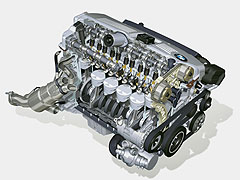Make / Model Search
New models - BMW - 5 SeriesFirst drive: BMW presents a higher FiveIt's all good: more power, less weight and reduced fuel consumption in the upgraded 525i and 530i sedans equals more fun for less money. BMW blesses its 525i and 530i sedans with cracking new six-cylinder power7 Jul 2005 BMW has introduced two new powerplants to its 5 Series range, with the 525i and 530i sedans benefiting from ground-breaking new R6-series 2.5 and 3.0-litre engine technology. Also released this month in the new E60 530i Touring, the new-generation 3.0-litre inline six was first seen in the redesigned E90 330i sedan released last month, while the re-powered 525i beats the 325i sedan on sale here by two months. Bristling with new technology including BMW’s first use of a magnesium-aluminium composite crankcase, both engines are lighter, more powerful and more fuel efficient than the identical-capacity engines they replace. Also featuring Valvetronic cam control and a power and fuel-saving electric water pump, both engines produce their peak torque outputs at lower revs and reduce both variants’ kerb weights by 5kg, increasing both acceleration and top speed. This is thanks to what BMW claims is the lightest six-cylinder crankcase in a volume production anywhere in the world, weighing 24 per cent less than a comparable aluminium crankcase. Like the 330i, the updated 530i now delivers an extra 20kW (190kW) at 6600rpm, plus the same 300Nm from a slightly lower 2500rpm.  Weighing 161kg (10kg or seven per cent less than before), the new 3.0-litre BMW six now pushes the 530i to 100km/h in 6.7 seconds (down from 7.1 seconds) and returns 9.3L/100km on the combined EU cycle (down from 9.9L/100km). Weighing 161kg (10kg or seven per cent less than before), the new 3.0-litre BMW six now pushes the 530i to 100km/h in 6.7 seconds (down from 7.1 seconds) and returns 9.3L/100km on the combined EU cycle (down from 9.9L/100km).Along with extra midrange flexibility, the new 530i now also claims an electronically-limited 250km/h top speed, up from 242km/h. Similarly, like the forthcoming 325i, the revised 525i delivers 160kW at 6500rpm and 250Nm from 2750rpm – up from the previous engine’s 141kW at 6000rpm and 245Nm at 3500rpm. Thus, 525i now accelerates to 100km/h in a claimed 7.9 seconds (8.7 seconds previously), while top speed has increased from 230km/h to 242km/h and fuel consumption reduces from 9.9 to 9.4L/100km on the combined EU cycle. All new models Alfa Romeo Alfa Romeo Abarth Abarth Audi Audi Aston Martin Aston Martin BMW BMW Bentley Bentley Chrysler Chrysler Chevrolet Chevrolet Dodge Dodge Citroen Citroen Ferrari Ferrari DS DS Ford Ford Fiat Fiat FPV FPV Foton Foton Haval Haval Great Wall Great Wall Honda Honda Holden Holden Hyundai Hyundai HSV HSV Isuzu Isuzu Infiniti Infiniti Jaguar Jaguar Iveco Iveco Kia Kia Jeep Jeep Land Rover Land Rover Lamborghini Lamborghini Maserati Maserati Lexus Lexus McLaren McLaren Mazda Mazda Mercedes-Benz Mercedes-Benz Mitsubishi Mitsubishi Mini Mini Opel Opel Nissan Nissan Porsche Porsche Peugeot Peugeot Ram Ram Proton Proton Rolls-Royce Rolls-Royce Renault Renault Skoda Skoda Saab Saab SsangYong SsangYong Smart Smart Suzuki Suzuki Subaru Subaru Toyota Toyota Tesla Tesla Volvo Volvo5 Series pricing
Motor industry news |
|









Facebook Twitter Instagram